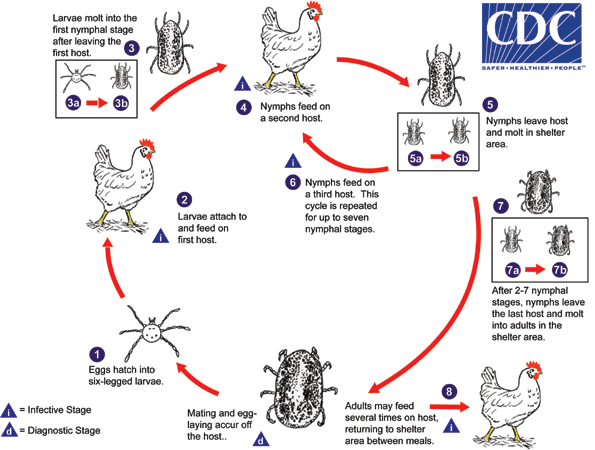
Ticks
[Amblyomma spp.] [Dermacentor spp.] [Ixodes spp.] [Ornithodoros spp.] [Rhipicephalus spp.]
Causal Agent
There are many genera and species of ticks in the families Ixodidae (hard ticks) and Argasidae (soft ticks) that are of public health importance. Some representative genera, and diseases they are known vectors for, include: Amblyomma (tularemia, ehrlichiosis, Rocky Mountain spotted fever (RMSF), and boutonneuse fever); Dermacentor (RMSF, Colorado tick fever, tularemia, Siberian tick typhus, and Central European tick-borne encephalitis, as well as being an agent of tick paralysis); Hyalomma (Siberian tick typhus, Crimean-Congo hemorrhagic fever); Ixodes (Lyme disease, babesiosis, human granulocytic ehrlichiosis, and Russian spring-summer encephalitis); Rhipicephalus (RMSF and boutonneuse fever); Ornithodoros (tick-borne relapsing fever); Carios (tick-borne relapsing fever).
Life Cycles
Most tick species undergo one of four different life cycles. Members of the family Ixodidae undergo either one-host, two-host or three-host life cycles. During the one-host life cycle, ticks remain on the same host for the larval, nymphal and adult stages, only leaving the host prior to laying eggs. During the two-host life cycle, the tick molts from larva to nymph on the first host, but will leave the host between the nymphal and adult stages. The second host may be the same individual as the first host, the same species, or even a second species. Most ticks of public health importance undergo the three-host life cycle, whereby the tick leaves the host after the larval and nymphal stages. The three hosts are not always the same species, but may be the same species, or even the same individual, depending on host availability for the tick. Members of the family Argasidae undergo what is called a multihost life cycle. Argasid ticks have two or more nymphal stages, each requiring a blood meal from a host. Unlike the ixodid ticks, which stay attached to their hosts for up to several days while feeding, argasid ticks are adapted to feeding rapidly (about an hour) and then promptly leaving the host.
One-Host Ixodid Tick Life Cycle
Two-Host Ixodid Tick Life Cycle
Three-Host Ixodid Tick Life Cycle
Multihost Argasid Tick Life Cycle
Mating usually occurs, and egg-laying always occurs, off the host in a sheltered area (usually an animal nest). Eggs hatch into six-legged larvae  in the parents’ sheltered area. They quest for a host in the vicinity of the sheltered area. Once a suitable host is found, they feed for anywhere from one hour to several days, depending on the species
in the parents’ sheltered area. They quest for a host in the vicinity of the sheltered area. Once a suitable host is found, they feed for anywhere from one hour to several days, depending on the species  . After feeding, the larvae leave the host and molt into the first nymphal instars in the sheltered area
. After feeding, the larvae leave the host and molt into the first nymphal instars in the sheltered area  -
-  . The nymphs quest for, and feed on, the second host
. The nymphs quest for, and feed on, the second host  rapidly (usually about an hour). The second host is usually the same species, and often the same individual, as the first host. The first nymphal instars leave the host and molt into the next nymphal instars in the sheltered area
rapidly (usually about an hour). The second host is usually the same species, and often the same individual, as the first host. The first nymphal instars leave the host and molt into the next nymphal instars in the sheltered area  -
-  . This cycle can continue to accommodate up to seven nymphal instars
. This cycle can continue to accommodate up to seven nymphal instars  , depending on the species. After the last nymphal instar has fed, it leaves the host and molts into an adult
, depending on the species. After the last nymphal instar has fed, it leaves the host and molts into an adult  -
-  in the sheltered area. Adults may continue to feed on the host
in the sheltered area. Adults may continue to feed on the host  , feeding rapidly and detaching after each blood meal. Females of some species lay egg batches after each meal. Humans are usually only incidental hosts for argasid ticks and may be fed upon by any of the stages.
, feeding rapidly and detaching after each blood meal. Females of some species lay egg batches after each meal. Humans are usually only incidental hosts for argasid ticks and may be fed upon by any of the stages.
Geographic Distribution
While ticks as a whole are worldwide in distribution, most species are restricted to various regions. All major biogeographic regions (except Antarctica) have tick species of public health importance.
Clinical Presentation
Most ticks do not elicit any response from their host while feeding. Ticks in the genera Dermacentor and Ixodes have been implicated in tick paralysis, a condition characterized by an acute, ascending, flaccid motor paralysis that can result in death if the tick is not removed. The condition is believed to be caused by toxins in the ticks' saliva.
Amblyomma americanum and Amblyomma spp.
Members of the genus, Amblyomma, are known vectors of a variety of diseases in humans. In North America, A. americanum transmits Francisella tularensis (tularemia), Ehrlichia chaffensis (ehrlichiosis), and Rickettsia rickettsii (Rocky Mountain spotted fever, or RMSF). In Africa, A. hebraeum transmits Rickettsia conorii (boutonneuse fever); in Central and South America, A. cajennense transmits RMSF. Members of the genus Amblyomma are characterized by having mouthparts noticeably longer than the basis capituli, a usually ornate dorsal shield, eyes present on the dorsal shield, and festoons (which may be difficult to see in engorged specimens). Adult females of A. americanum have a distinctive white spot near the posterior end of the dorsal shield.
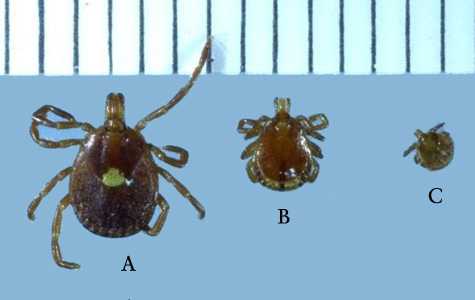
Figure A: Adult female (A), male (B), and nymph (C) of A. americanum. Notice the characteristic white spot on the female's dorsal shield. Image courtesy of James Occi.
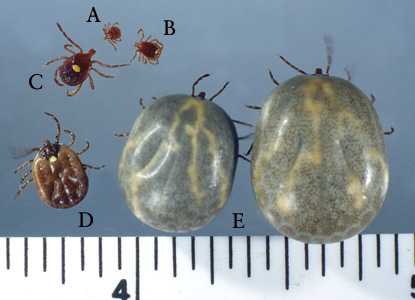
Figure B: Nymph (A), male (B), female (C), partially-engorged female (D) and two fully-engorged adults (E) of A. americanum. Image courtesy of James Occi.
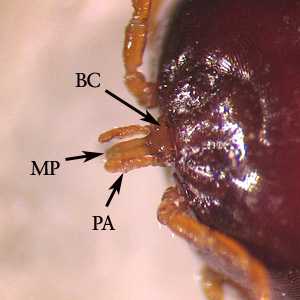
Figure C: Close-up of the mouthparts of A. americanum. Notice the mouthparts (MP) and palps (PA) are long, in comparison with the basis capituli (BC).
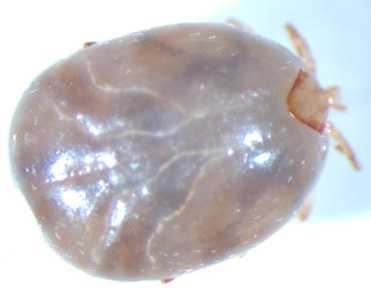
Figure D: Dorsal view of an engorged nymph of Amblyomma sp., collected on a patient with travel history to Peru. Notice the festoons are not visible in the specimen due to the engorged state. Images courtesy of the Washington State Public Health Laboratories.
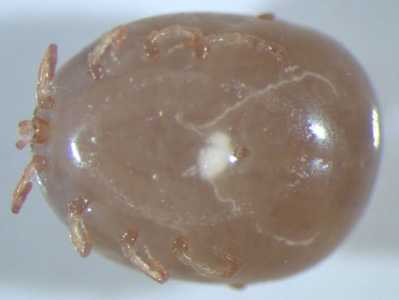
Figure E: Ventral view of an engorged nymph of Amblyomma sp., collected on a patient with travel history to Peru. Notice the festoons are not visible in the specimen due to the engorged state. Images courtesy of the Washington State Public Health Laboratories.
Dermacentor andersoni and D. variabilis.
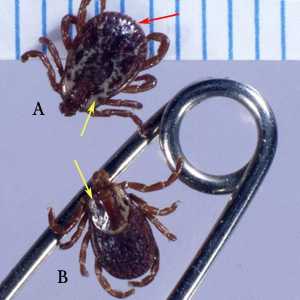
Figure A: Male (A) and female (B) of D. variabilis. Notice the ornate dorsal shields (yellow arrows), which on the male covers most of the tick's body. Also notice the presence of festoons (red arrow). Image courtesy of James Occi.
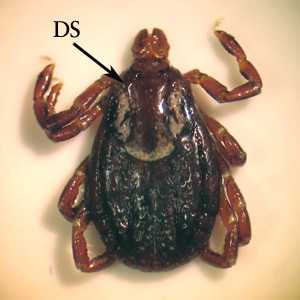
Figure B: Female specimen of D. variabilis. Notice the ornate dorsal shield (DS).
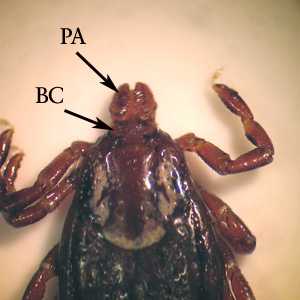
Figure C: Higher-magnification of the specimen in Figure B. Notice the palps (PA) are short in relation to the basis capituli (BC).
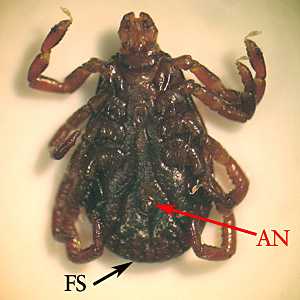
Figure D: Underside of the specimen in Figure B, showing the anus (AN) and festoons (FS).
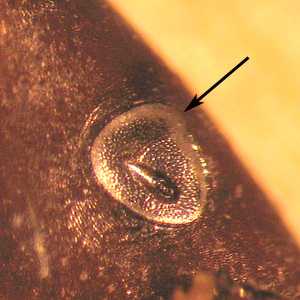
Figure E: Spiracular plate of D. variabilis. Notice the slight dorsal prolongation (arrow) of the plate and large number of smaller goblet cells on the plate.
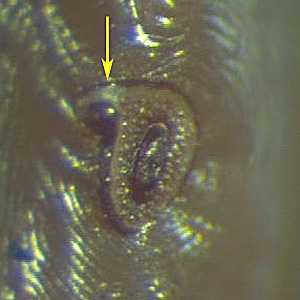
Figure F: Spiracular plate of D. andersoni. Notice the more pronounced dorsal prolongation (arrow) of the plate and the larger, yet fewer in number, goblet cells on the plate. Image courtesy of the Washington State Public Health Laboratories.
Ixodes scapularis and Ixodes spp.
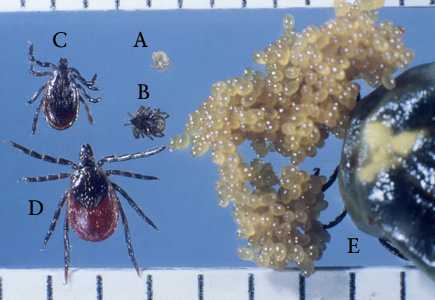
Figure A: Larva (A), nymph (B), adult male (C), adult female (D), and engorged adult female with eggs (E) of I. scapularis. Image courtesy of James Occi.
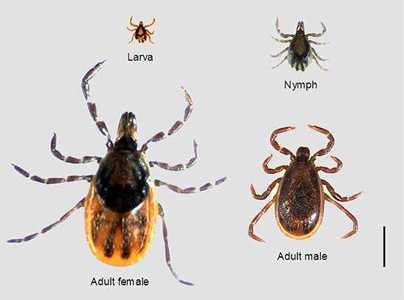
Figure B: Adult female, adult male, nymph and larva of I. scapularis. Image courtesy of Dr. Marc Dolan.
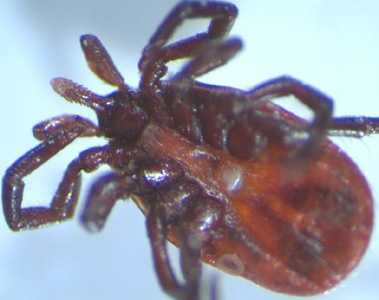
Figure C: Ventral view of a nymph of Ixodes sp. Image courtesy of the Washington State Public Health Laboratories.
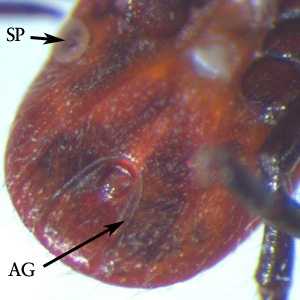
Figure D: Higher-magnification of the specimen in Figure C, showing a spiracular plate (SP) and the inverted, U-shaped anal groove (AG). Notice also the absence of festoons.
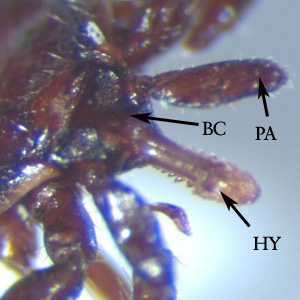
Figure E: Dorsal view of the specimen in Figure C, showing a close-up of the anterior region. Notice the hypostome (HY) and palps (PA) are long, in relation to the basis capituli (BC).
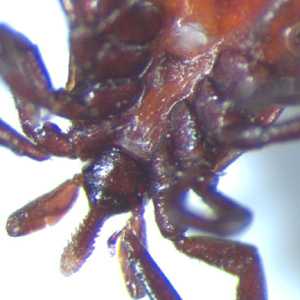
Figure F: Ventral view of the specimen in Figure C, showing a close-up of the anterior region.
Rhipicephalus sanguineus.
Rhipicephalus sanguineus is known as the brown dog tick and is found nearly worldwide. Humans are not the usual host, but there are increasing reports of disease transmission with this species, including Rickettsia rickettsii (Rocky Mountain spotted fever, or RMSF) and Rickettsia conorii (boutonneuse fever). Adults are characterized by having a laterally-produced, angulate basis capituli, a dorsal shield with eyes, festoons, and deeply-cleft front coxae. The festoons and anal groove may be difficult to see in engorged specimens. The mouthparts are relatively short, in relation to the basis capituli.
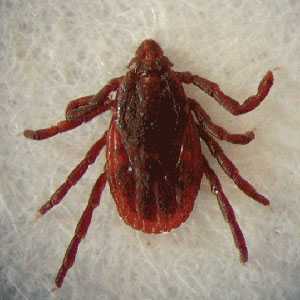
Figure A: Female of R. sanguineus.
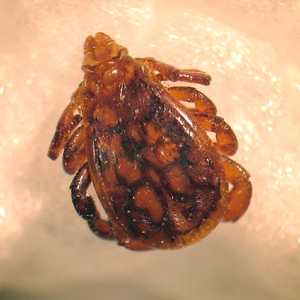
Figure B: Male of R. sanguineus.
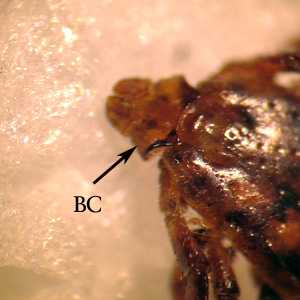
Figure C: Close-up of the specimen in Figure B. Notice the laterally-produced, angulate basis capituli (BC).
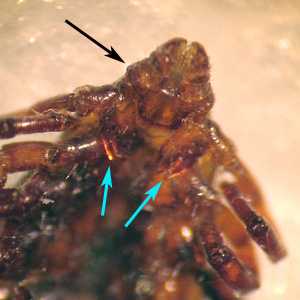
Figure D: Ventral view of the specimen in Figures B and C. Notice the laterally-produced, angulate basis capituli (black arrow) and deeply-cleft fore coxae (blue arrows).

Figure E: Female (left) and male (right) of R. sanguineus. Image courtesy of James Occi.
Ornithodoros moubata and O. turicata.
Members of the genus, Ornithodoros, are known vectors of Borrelia hermsi (tick-borne relapsing fever, or TBRF) in North America and several TBRF spirochetes in Africa. Like most members of the Argasidae, or soft ticks, Ornithodoros spp. are characterized by lacking a dorsal shield and not displaying marked sexual dimorphism. Their mouthparts are subterminally attached and not visible from above. Adults and developing nymphs do not remain attached to their hosts, as do members of Ixodidae; rather they are adapted to feeding rapidly and leaving the host promptly.
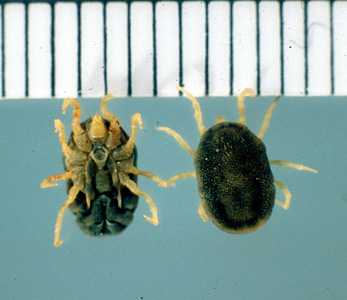
Figure A: Ventral (left) and dorsal (right) views of O. turicata, a known vector of TBRF spirochetes in the midwestern and southwestern United States. Image courtesy of James Occi.
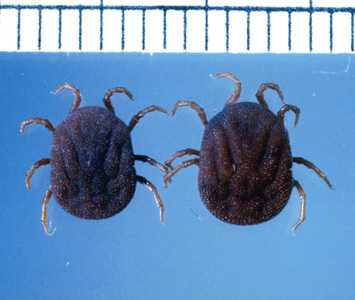
Figure B: Ornithodoros moubata, a known vector for African TBRF spirochetes. Image courtesy of James Occi.
Laboratory Diagnosis
In most cases, ticks need only to be identified to the genus level to rule-out potential vectors of disease. Ticks are best identified by examining non-engorged adults. Nymphs may lack certain diagnostic features and in engorged individuals, certain features (festoons, anal groove) may be difficult to see. The geographic location of the tick can also be important for accessing the public health importance.
Treatment Information
There is no specific treatment for ticks specifically, outside of the complete removal of the parasite from the skin. Ticks are best removed by firmly grasping the mouthparts with fine forceps, and gently pulling away at a 45° angle. Vaseline and other ointments should not be used, as they cause the ticks to vomit, possibly inoculating the host with a pathogen. The best way to control ticks, and reduce the chances of acquiring tick-borne diseases, is habitat management (decreasing humidity and harborage that support egg-laying and sheltered areas).
DPDx is an education resource designed for health professionals and laboratory scientists. For an overview including prevention and control visit www.cdc.gov/parasites/.
- Page last reviewed: May 3, 2016
- Page last updated: May 3, 2016
- Content source:
- Global Health – Division of Parasitic Diseases and Malaria
- Notice: Linking to a non-federal site does not constitute an endorsement by HHS, CDC or any of its employees of the sponsors or the information and products presented on the site.
- Maintained By:


 ShareCompartir
ShareCompartir
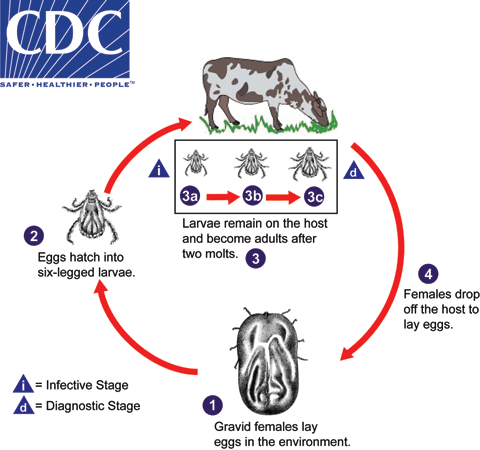
 . Although humans may serve as incidental hosts for species normally found on other animals, they usually do not host all three stages. Females drop from the host to lay eggs
. Although humans may serve as incidental hosts for species normally found on other animals, they usually do not host all three stages. Females drop from the host to lay eggs 
 , usually a rodent or lagomorph. The larvae molt into nymphs on the first host
, usually a rodent or lagomorph. The larvae molt into nymphs on the first host  and seek out the second host
and seek out the second host 
 . Nymphs molt into adults
. Nymphs molt into adults 